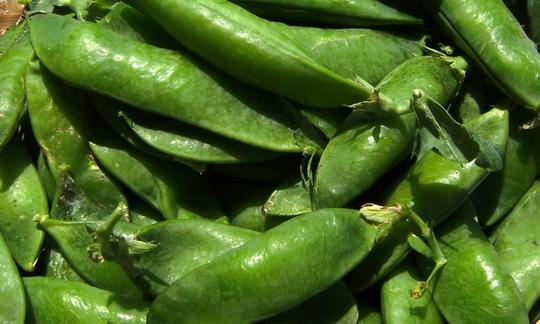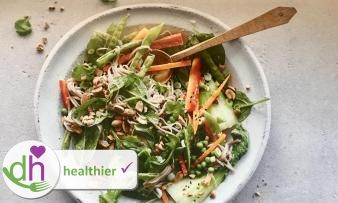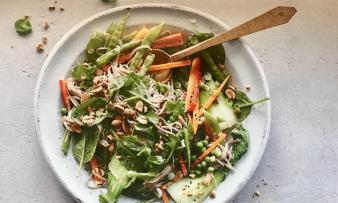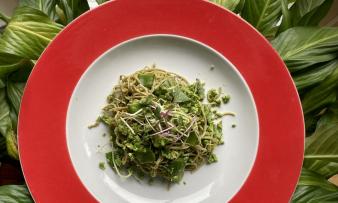Table of contents
The sugar pea, also called sugar snap pea or sugar pod, can be eaten including the pod, unlike other types of peas.
Use in the kitchen
Can you eat sugar snap peas raw? Sugar snap peas can be eaten raw like peas because they contain very little phasin. Young sugar snap peas do not have an inedible parchment layer on the inside of the pod, so they can be eaten with the tender, unripe pod. However, the threads that grow along the pods should be removed before eating, as they are difficult to chew. After washing the sugar snap peas thoroughly in water, any stem ends should be cut off at the end of the pod.
Raw sugar snap peas are a great snack for dipping. Sliced sugar snap peas also go well in a crisp summer salad. The fresher the sugar snap peas, the sweeter they are. A crisp, raw sugar snap pea salad is easy to make with dates, walnuts and lemon juice.
How do you prepare turnips? If you want to cook the turnips, you should only blanch them briefly, otherwise they will lose their green color and crispy freshness. To do this, simmer the pods in boiling water for 2-3 minutes and then plunge them into ice water. You can also briefly sauté the turnips in a frying pan. Turnips are ideal as a crunchy side dish, for example in a vegetable pan with tofu, sweet peppers, carrots andsweetcorn kernels. They also go well as a soup garnish or in curry.
Vegan recipe for basil-carrot-swallow salad
Ingredients (for 4 people): 320 g swallows, 300 g carrots, 2 bunches of fresh basil, 1 clove of garlic, 3 tbsp white balsamic vinegar, 3 tbsp cold-pressed rapeseed oil, salt andblack pepper, 30 g pine nuts.
Preparation: Clean and prepare the turnips and blanch them in boiling salted water for 3 minutes. Then immediately rinse in cold water and let them dry. Wash the carrots and cut into thin slices. Wash the basil, shake dry and pluck the leaves from the stems. Peel the garlic and press it into a bowl. Mix the garlic with the balsamic vinegar and rapeseed oil and season with salt and pepper. Mix the turnips, carrots and basil leaves with the dressing. Just before serving, mix the pine nuts into the salad.
Vegan recipes with sugar snap peas can be found under the note: " Recipes that have the most of this ingredient ".
| Not only vegans or vegetarians should read this: Vegans often eat unhealthily. Avoidable nutritional errors. |
Purchasing - Storage
Sugar snap peas can often be found in the range of large supermarket chains such as Coop, Migros, Denner, Volg, Spar, Aldi, Lidl, Billa, Rewe, Edeka or Hofer, occasionally also in controlled organic quality (organic quality). Sugar snap peas can also be bought in organic supermarkets such as Denn's Biomarkt or Alnatura, as well as seasonally at the weekly market. The main season for sugar snap peas is between May and October. 2
The availability of sugar snap peas in the supermarkets mentioned varies depending on the size of the store, catchment area, etc. If you are interested, click on our recorded food prices for the DA-CH countries (above under the ingredient image). There you will find current prices from various supermarkets and their price development.
Storage tips
They will keep in the fridge for about 1 to 2 days. However, the sugar content of the pods decreases the longer they are stored. It is best to wrap the snap peas in a damp kitchen towel and put them in the vegetable compartment. If you blanch them and then rinse them, you can easily keep them for longer or freeze them. 2
Ingredients - Nutritional values - Calories
Raw skewers (organic) are low in calories and fat. They contain only 42 kcal and 0.2 g fat per 100 g. The carbohydrate content is 7.6 g and the protein content 2.8 per 100 g of skewers. They contain 2.6 g fiber. This corresponds to 10.4% of the daily requirement. 1
With 60 mg per 100 g, squash contains a lot of vitamin C. This corresponds to 75.0% of the daily requirement. This is comparable to oranges (71 mg/100g). Raw kale contains even more vitamin C: 120 mg/100 g, which corresponds to 150% of the daily requirement. 100 g of raw, yellow bell peppers contain so much vitamin C that 229% of the daily requirement is covered (184 mg/100g). 1
The vitamin K content is 25 μg/100g. This corresponds to 33.0% of the daily requirement of vitamin K1. Sauerkraut and green peas have a similar value. Raw kale (705 μg/100g) and chard (830 μg/100g) have very high vitamin K values. This corresponds to 940% and 1107% of the recommended daily dose. 1 The absorption rate is 20 - 70% (absorption rate of the vitamin in the body). Toxic properties of vitamin K from food are not known. 3
Folate (folic acid) is also found in turnips with 42 µg per 100 g. This corresponds to 21.0% of the daily requirement. White cabbage (43 µg/100g) and cooked quinoa (42 µg/100g) have similar values. Young spinach contains more folate, which can be eaten raw as a salad. Raw spinach contains 194 µg per 100 g, which covers 97% of the daily requirement of folate. 1
You can find all the ingredients of Kefen, the coverage of the daily requirement and comparison values with other ingredients in our nutrient tables. In the article Nutrients explained you will get a detailed insight into the topic.
Health effects
Are sugar snap peas healthy? Raw sugar snap peas (organic quality) are healthy because they contain important vitamins and minerals and are rich in fiber.
Kefen are very rich in vitamin C. 100 g of it cover around 75.0% of the daily requirement. 1 Vitamin C is a water-soluble vitamin and antioxidant in the body. Vitamin C performs a variety of tasks in the body. Among other things, it inhibits the formation of carcinogenic nitrosamines from nitrite and amines in the stomach and promotes the absorption of iron. 3
Dietary fiber has a number of positive effects on our health. It is responsible for a healthy digestive system 13, has a positive effect on blood sugar levels when eating carbohydrates and starchy foods and can thus reduce the risk of type 2 diabetes 14. A diet rich in fiber leads to a feeling of satiety for longer, which can help with weight loss. 15
Like other legumes, sugar snap peas are a good source of protein and are therefore popular in vegetarian and vegan cuisine. However, sugar snap peas contain less protein at 2.8 g than green peas at 5.4 g per 100 g. In comparison, cooked red lentils, kitchen lentils and chickpeas contain 9.0 g/100 g. 1
Dangers - Intolerances - Side effects
Sugar snap peas are a type of legume that has a high nutritional value but can also cause severe allergic reactions. Some of the most potent and widespread allergenic foods belong to the legume family (peanut, soybean and lupine). 7 In contrast to these, peas are not an ingredient for mandatory allergen labeling. Severe allergic reactions in children and adults have been documented, but are rare. 10,11,12 People with an allergy to legumes should be careful when eating sugar snap peas. Some people are allergic to all legumes, while others only react to certain ones. People with a peanut allergy in particular often also react to soy, lupine and peas. 11 However, cross allergies have also been documented between lentils, chickpeas and peas. 12 The food industry is increasingly replacing soy protein with pea protein. It is therefore important to look out for 'hidden' protein from peas in products. 11
snap
Sugar peas with pods are somewhat similar to edamame (young soybeans with shells). However, these are usually plumper and thicker than the flat sugar snap peas and cannot be eaten raw; they must be cooked before consumption.
Ecological footprint - animal welfare
The ecological CO 2 footprint of sugar snap peas is quite low at 0.74 CO 2 eq/kg. 16 To produce 1 kg of green peas, 595 litres of water are needed, similar to the amount of water needed to produce green beans (547 litres) or okra (576 litres). 17
Legumes such as sugar snap peas or soybeans bind important nitrogen in their root nodules, which is then available to other plants in the soil after harvesting and naturally increases soil fertility. Accordingly, they are suitable plants for crop rotation in organic farming. In addition, the integration of legumes in crop rotation can help to break the life cycle of certain pathogens, make important nutrients available and improve soil structure. 18
When buying peas, you should choose organically grown peas. In contrast to conventional farming, no synthetic fertilizers or pesticides are used here. These are often found in the end product, as is the case with peas. 19 You should also pay attention to regionality when buying squash - compared to products from overseas, vegetables from the region save long journeys (sometimes by plane), which means that the ecological footprint is not increased unnecessarily.
Worldwide occurrence - cultivation
Peas originally come from the Near East and the Western Asia and have been cultivated since 10,000 BC. Sugar peas are a more recent form of cultivation and a particularly sweet type of pea that has been cultivated in Europe since the 16th century. The Dutch introduced sugar peas to China, where they remain a popular vegetable to this day. 5
In international trade, no distinction is made between green peas (garden peas) and sugar peas. According to FAOSTAT, around 21.8 million tons of green peas (including sugar peas) were grown worldwide in 2020. The main growing areas are China, India and the USA. 6 Peas are important sources of protein in many parts of the world.
Wildly found
sugar snap peas have been bred from the garden pea ( Pisum sativum subsp. sativum). Neither pea variety is found in the wild. Their wild relatives are the wild pea ( Pisum sativum subsp. elatius, Pisum sativum L. subsp. biflorum ( Raf.) Soldano), which is found in the Mediterranean region and parts of Central Asia as far as Iran and Turkmenistan. 8 And Pisum fulvum Sibth. & Sm., which is only found in the wild in the Middle East. 9
Cultivation - Harvest Sugar
snap peas can be grown well in the garden bed or in a sufficiently large pot. Sugar snap peas prefer an airy and sunny location. The soil should be rich in humus, loose and evenly moist. Sow the seeds directly in the bed towards the end of April. The ideal soil temperature is 5-8 °C. The seed furrow should be 3 cm deep. The distance between the seeds should be around 5 cm. Carefully cover with soil and water well. Sugar snap peas can grow 50 to 100 centimeters high, which is why they need a stable framework or a trellis. When the plants are around 15 cm high, they should be lightly mounded up. 4
The sugar snap peas can be harvested after about three months. From May onwards, the mostly white butterfly flowers appear, from which the five to ten centimetre long pods grow. Each pod contains four to ten seeds. As soon as the pods are fresh, green and translucent, the sugar snap peas can be harvested. The peas should still be small. This is usually the case at the end of June. 4
Further information
What are sugar peas? The sugar pea or mangetout ( Pisum sativum L. var. macrocarpum Ser.) is a variant of the garden pea ( Pisum sativum L.). It belongs to the subfamily Faboideae within the family Fabaceae or Leguminosae. The mangetout is sometimes also known as Pisum sativum L. subsp. sativum convar. axiphium Alef. or Pisum sativum L. var.
Alternative names
Sugar snap peas are also called sugar peas, sugar snap peas, snap peas, snow peas or mange-tout (sometimes also written as mangetout). The latter name is derived from the French and means 'everything-eating'. The name comes from the fact that sugar snap peas are eaten with the pod and not just the peas inside.
In English, sugar peas are called snow peas or sugar snap peas. They are also sometimes called Chinese peas because they are often used in Chinese dishes.
Bibliography - 19 Sources
| 1. | USDA United States Department of Agriculture. |
| 2. | Apothekenumschau. Zuckererbsen: Süsse Schoten. |
| 3. | Biesalski H K, Grimm P. Taschenatlas der Ernährung. Stuttgart: Georg Thieme Verlag; 2015, 6. Auflage. |
| 4. | Mein schöner Garten. Zuckerschoten, Zuckererbsen. |
| 5. | Kiple KF, Ornelas KC, Press CU. The cambridge world history of food. Cambridge University Press; 2000. 1861-1862. |
| 6. | FAOSTAT Food and Agriculture Organization of the United Nations. Peas, green (2020). |
| 7. | Medizinische Universität Wien. Die 14 wichtigsten Allergene. |
| 8. | Kosterin OE, Bogdanova VS, Mglinets AV. Wild pea (Pisum sativum L. subsp. elatius (Bieb.) Aschers. et Graebn. s.l.) at the periphery of its range: Zagros Mountains. Vavilovskii Zhurnal Genet Selektsii. 2020 Feb;24(1): 60-68. |
| 9. | Smýkal P, Hradilová I, Trněný O, Brus J, Rathore A, Bariotakis M, Das RR, Bhattacharyya D, Richards C, Coyne CJ, Pirintsos S. Genomic diversity and macroecology of the crop wild relatives of domesticated pea. Sci Rep. 2017 Dec 12;7(1): 17384. |
| 10. | Popp J, Trendelenburg V, Niggemann B, Randow S, Völker E, Vogel L, Reuter A, Spiric J, Schiller D, Beyer K, Holzhauser T. Pea (Pisum sativum) allergy in children: Pis s 1 is an immunodominant major pea allergen and presents IgE binding sites with potential diagnostic value. Clin Exp Allergy. 2020 May;50(5): 625-635. |
| 11. | Hildebrand HV, Arias A, Simons E, Gerdts J, Povolo B, Rothney J, Protudjer JLP. Adult and Pediatric Food Allergy to Chickpea, Pea, Lentil, and Lupine: A Scoping Review. J Allergy Clin Immunol Pract. 2021 Jan;9(1): 290-301. |
| 12. | Cabanillas B, Jappe U, Novak N. Allergy to Peanut, Soybean, and Other Legumes: Recent Advances in Allergen Characterization, Stability to Processing and IgE Cross-Reactivity. Mol Nutr Food Res. 2018 Jan; 62(1). |
| 13. | Gill SK, Rossi M, Bajka B, Whelan K. Dietary fibre in gastrointestinal health and disease. Nat Rev Gastroenterol Hepatol. 2021 Feb;18(2): 101-116. |
| 14. | Evans CEL. Dietary fibre and cardiovascular health: a review of current evidence and policy. Proc Nutr Soc. Februar 2020;79(1): 61–7. |
| 15. | Miketinas DC, Bray GA, Beyl RA, Ryan DH, Sacks FM, Champagne CM. Fiber intake predicts weight loss and dietary adherence in adults consuming calorie-restricted diets: the pounds lost (Preventing overweight using novel dietary strategies) study. J Nutr. 1. Oktober 2019;149(10): 1742–8. |
| 16. | CONCITO (2021): The Big Climate Database, version 1 |
| 17. | Mekonnen MM, Hoekstra AY. The green, blue and grey water footprint of crops and derived crop products. Hydrol. Earth Syst. Sci. 2011; 15: 1577-1600. |
| 18. | Böhm H, Dauber J, Dehler M, et al. Fruchtfolgen mit und ohne Leguminosen: ein Review. Journal für Kulturpflanzen. 2020; 489-509. |
| 19. | Pesticide Action Network Europe. Forbidden fruit. 2022. |











Comments